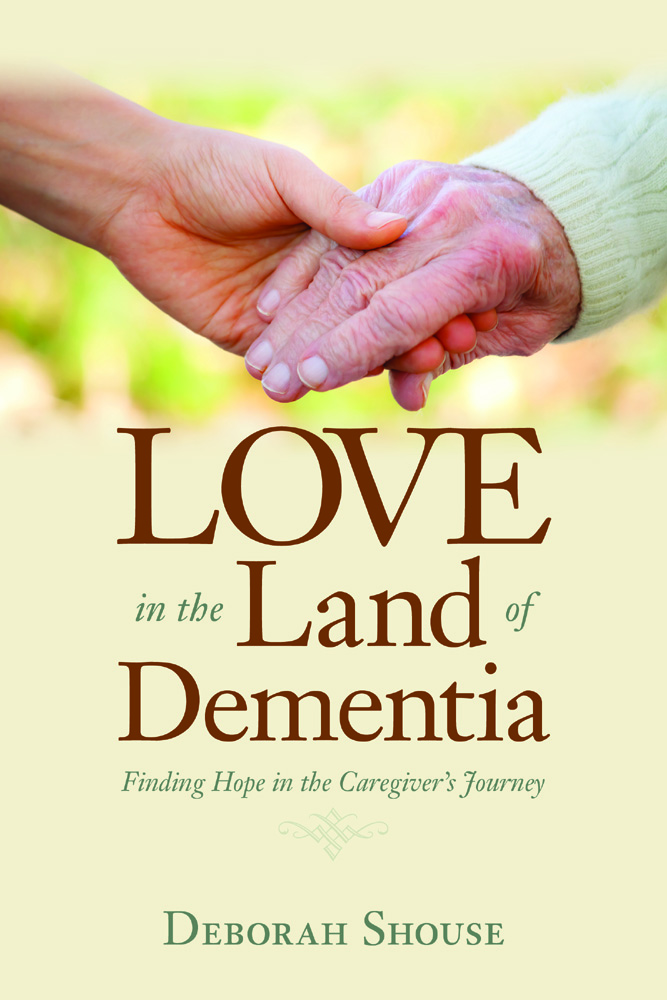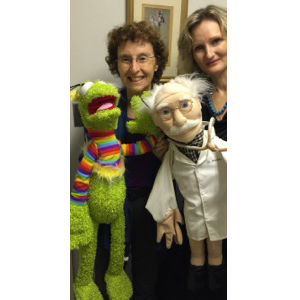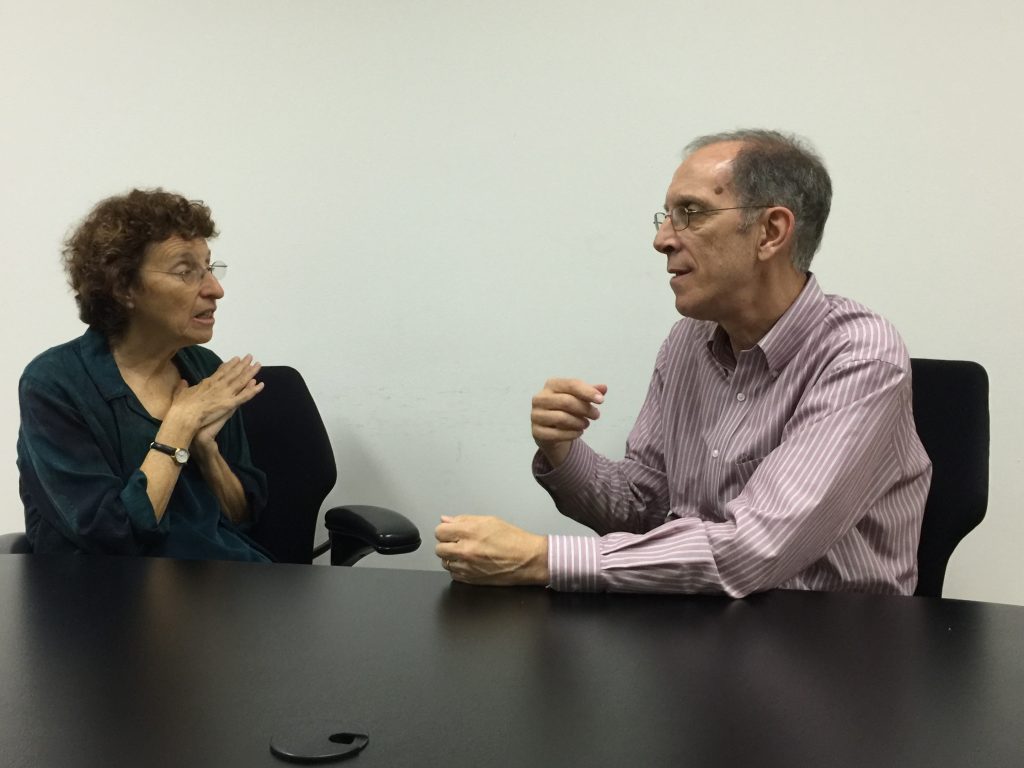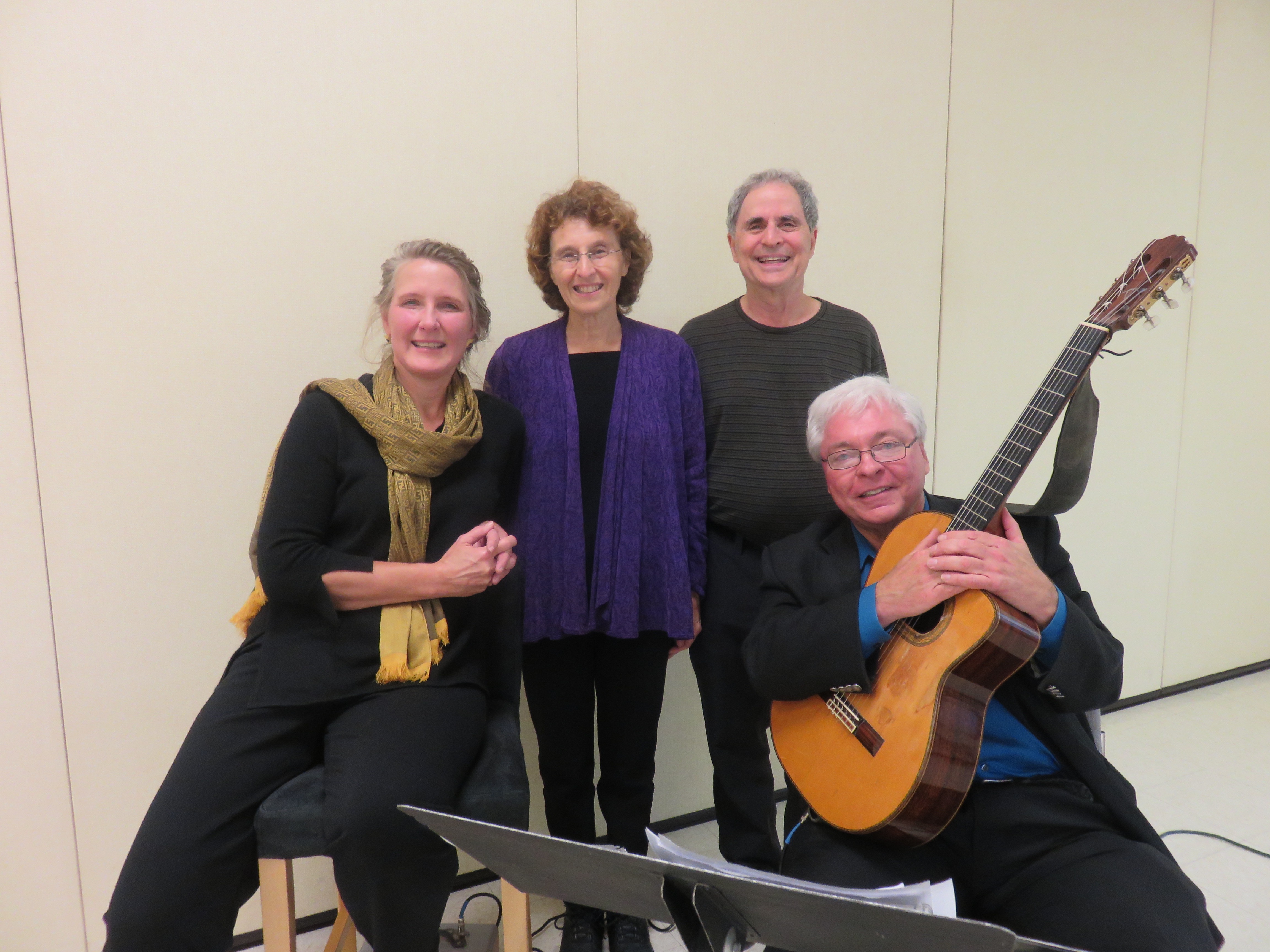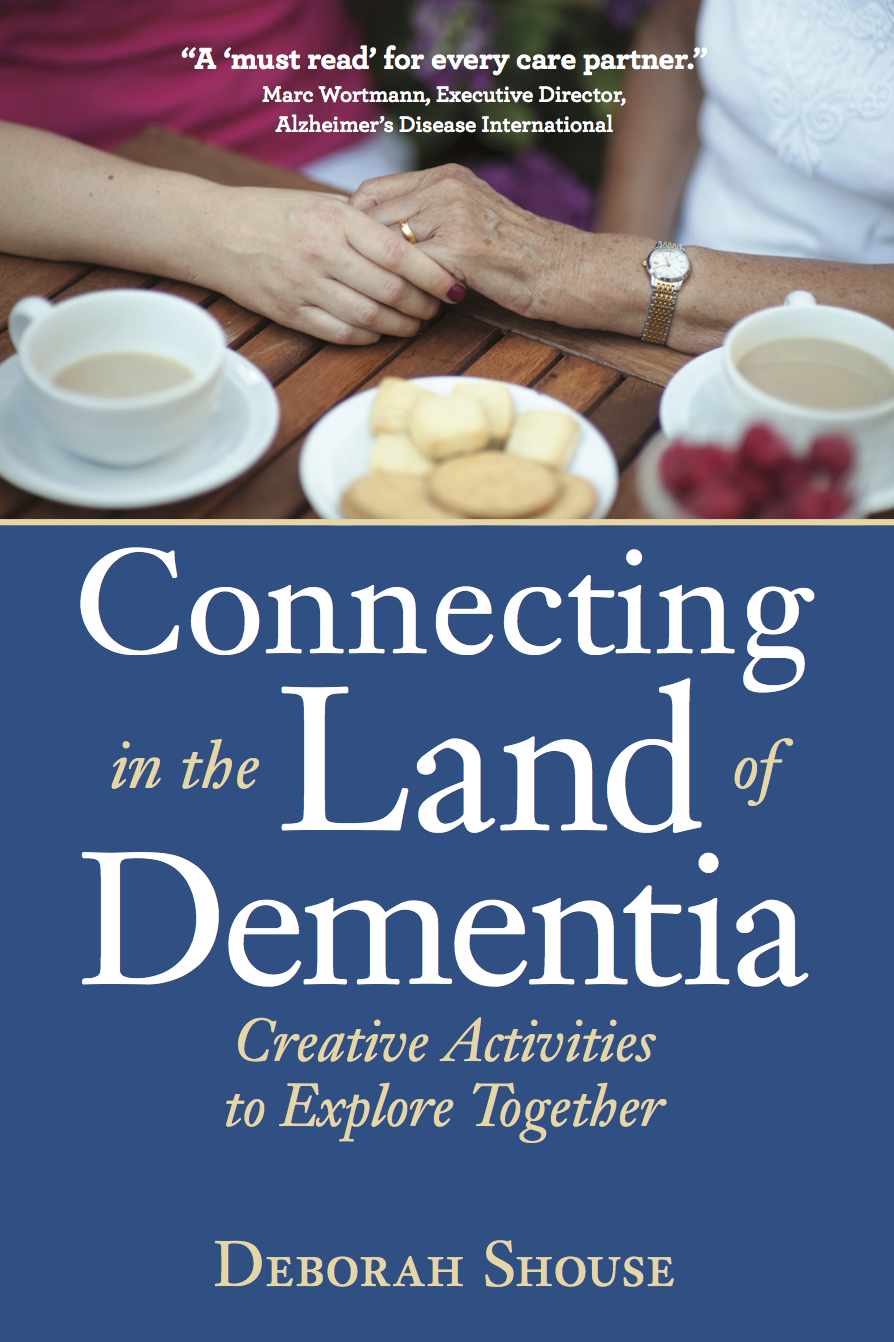Posts Tagged ‘dementia’
Tuning into Music for Connection: Helping Children Accept Dementia
“Oh what a beautiful morning,” I warbled. My mom clapped and hummed along. At the end of the song, she applauded. In her earlier days of motherhood, she might have winced slightly when I wandered off-key. But in the cradle of dementia, she was delighted with my smile, my energy, and the sheer sound of my voice. And I was delighted to be tuning into music for connection.
Carol Bradley Bursack, an author, speaker, family care partner and creator of Minding Our Elders, recently told me the story of how she helped her teenage children stay connected with their grandfather. I loved her ideas and wanted to share her tips with you.
Tuning into Music for Connection
When he was in his 70s, Carol’s father went into surgery to help repair brain damage from a World War II injury. The doctors expected no issues, but during the operation, something went awry. Her beloved father emerged from the procedure deep in dementia, with a constant voice in his head, and no grasp of reality. Valiantly, Carol dealt with her anger and grief while finding a safe and compassionate care community for her father. Then she began searching out ways she and her sons could stay connected with him.
“Dad loved big band music,” Carol says. “I bought every CD I could find. He loved to direct and listen to the music.”
Finding a Musical Bridge
Carol’s sons were very close to their grandfather. He had always been there for them, a vibrant, fun presence, celebrating their abilities, playing chess with them, and listening to their stories. When her sons saw that Grandfather was so changed he couldn’t even hug them and no longer understood the chessboard, they were devastated.
“They didn’t know how to bond with him,” Carol says.
Carol understood their reluctance to visit and gave them some space. She didn’t make the children feel guilty about their feelings, but she did want them to maintain a relationship with their grandfather. Tuning into music for connection came to the rescue.
The boys both played instruments and Carol urged them to take their clarinet and trumpet to the care community. At first, they were hesitant. They stood shyly before this new grandfather, barely able to blow out the notes. But at the end of their first short tune, Grandfather beamed and asked for an encore. The boys grinned and played more confidently. People came from down the hallways, wanting to hear the music.
“The boys and their music had made a connection,” Carol says. “All three of them were happy and relaxed.”
Creating Together to Build Connection
Carol continued to seek ways to help her sons feel comfortable during their visits. She also wanted them to feel a sense of accomplishment and to cherish their relationship with their grandfather.
Sometimes the boys took hand-drawn pictures to decorate the walls. Other times, they showed up with examples of science projects and told their grandpa about them. The boys brought chess pieces, old photos from Grandpa’s younger days, and games that they’d played with Grandpa. They invited their grandfather to share stories about these objects and often he did.
“It’s hard for young minds to accept such changes,” Carol says. “Their grief can slide under the radar. I was constantly looking for activities we could share, projects that were mutually engaging and that Grandpa could understand.”
Through it all, their mutual love of music kept them together.
For more information on the important work Carol is doing, visit her website: www.mindingourelders.com.
And treat yourself to her book, Minding Our Elders.
Deborah Shouse is the author of Connecting in the Land of Dementia: Creative Activities to Explore Together and Love in the Land of Dementia: Finding Hope in the Caregiver’s Journey.
Live Well with Dementia: The Pygmalion Effect
“This is one of my favorite songs. What do you think of it, Fran?” We were sitting in Mom’s room in the memory care community, listening to a recording of The Very Thought of You. Even though my mother could no longer answer this question, I liked hearing my father ask it. He honored Mom as his long-time beloved conversational partner. Through this simple action, he was helping her live well with dementia. His example helped me do the same.
 This article by Karen Love, Executive Director of Dementia Action Alliance, reminded me of my dad’s positive outlook. It inspired and touched me and I wanted to share it with you.
This article by Karen Love, Executive Director of Dementia Action Alliance, reminded me of my dad’s positive outlook. It inspired and touched me and I wanted to share it with you.
Live Well with Dementia
By Karen Love, DAA Executive Director
In 1968, Robert Rosenthal and Lenore Jacobson published groundbreaking research that showed teacher expectations of students became self-fulfilling prophecies. At the beginning of a school year, first and second grade students’ IQs were tested. The researchers randomly selected a group of students regardless of their actual test results and led the teachers to believe that this group was capable of great academic achievement. The teachers, perhaps unwittingly, gave the students with the presumed higher IQs more positive reinforcements.
At the end of the year, the students were retested. The group labeled high academic achievers did, in fact, show higher achievement than the other students. Robert Rosenthal summarized this research finding as – “What one person expects of another can come to serve as a self-fulfilling prophecy.” This outcome, retested and proven by many others over the years, has become widely known as the Pygmalion Effect.
The dynamics of the Pygmalion Effect have significant impact for those who want to live well with dementia. There is abundant anecdotal evidence among person-centered dementia care experts that the Pygmalion Effect similarly applies. Family, friends, and others may have low expectations regarding what people living with dementia can and cannot do and how they can function and live. While they may not even be consciously aware of this view, these lowered expectations affect every aspect of the relationship. They don’t engage, interact, and provide opportunities for interesting and fun activities at the same level they would if their expectations were higher.
I experienced the Pygmalion Effect this past week at a memory care assisted living community. I saw a resident sitting alone, apart from the others. I asked a staff member about her and was told she had very advanced dementia.
“What does she like to do?” I asked.
“Nothing, she can’t do anything.”
I knelt beside her and offered a small pillow covered in a soothing, tactile fabric. She immediately started stroking the pillow and then explored the seams. Her expression turned sweet and serene. Touching the fabric was comforting to her. As I was getting ready to leave, the woman’s daughter arrived. I introduced myself and described how much her mother enjoyed the tactile pillow.
“Mom was a seamstress and loves the feel of fabric,” her daughter said, smiling at her mother. “I should bring one of the lap quilts she made when I visit.”
Her daughter was reminded of something her mother liked to do and she felt grateful she could bring something that would please her mom.
I was reminded how important it is to have interesting and engaging items when we visit. Examples include scented lotion, a tactile pillow or fabric scraps, and an enjoyable short story to read aloud.
Helping someone live well with dementia invites us to open our eyes, our hearts, and change our mindset. Instead of perceiving limitations, we can spark the Pygmalion Effect by setting positive expectations. We can help make living fully with dementia a self-fulfilling prophecy.
 Karen Love, gerontologist – Executive Director, Dementia Action Alliance – Powered by People with Purpose
Karen Love, gerontologist – Executive Director, Dementia Action Alliance – Powered by People with Purpose
Deborah Shouse is the author of Connecting in the Land of Dementia: Creative Activities to Explore Together and Love in the Land of Dementia: Finding Hope in the Caregiver’s Journey.
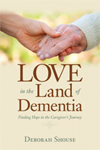

Sharing Your Caregiver’s Story
My mother’s Alzheimer’s drove me to write. My writing inspired me to speak. I have received enormous pleasure from connecting with people all over the world, sharing my stories from Connecting in the Land of Dementia and from Love in the Land of Dementia. Now, I’m offering you tips for sharing your caregiver’s story.
It All Started with Grief
When I initially realized the depth of my mother’s memory loss, I was shattered with grief.
Every day I went through this:
Visit with mom.
Drive home, wiping tears from my cheeks.
Stumble into the house, walk into a chair or table, and misplace my car keys.
Sit at the dining room table and stare numbly into space.
One day, during the “staring numbly” phase, my partner Ron said, “Are you writing down your feelings?” It was a smart and sensible thing to say; the sort of suggestion I might make to him in a crisis. I was, after all, a writer.
“I don’t feel like writing,” I said.
But his words stayed with me. The next day, I slightly altered my behavior.
Visit with mom.
Drive home, wiping tears from my cheeks
Stumble into the house, walk into a chair or table, and misplace my car keys
Sit at the dining room table and write numbly for 20 minutes
Pouring Emotions Out & Inviting Understanding In
I poured out my fears, anger, and grief. After doing this for a week,
I began noticing how interesting my visits with Mom were; we were explorers on a wild inner trek.
I started documenting our time together, sometimes even taking notes during my visits. I wrote about the challenges, humor and blessings. I wrote about my conversations with my father, with friends and family and with the aides, the nurses, the social workers. As I wrote, I saw there was much hope, promise and energy in my new world.
As I shared my work with friends and family, I realized I was chronicling my mom’s last years and capturing part of our family history.
Sharing Your Caregiver’s Story
How do you take a challenging part of your life and bring it to the page? Here are a few simple tips:
Pour Out Your Feelings
Give yourself time to feel your emotions, whether it’s through writing, art, music or other expressive arts. Writing down your feelings helps you understand the depth of what you’re going through. For me, writing helped change my fear into curiosity.
Notice the Details
Write down the particulars, noting simple concrete facts. You are a researcher collecting data.
Uncover the True Story
Look for the universal meaning in your specific experience. How have you changed? How will the reader change through reading your words?
Ask for Feedback
Read the story aloud to someone and see how it sounds. What’s working and what’s missing? Ask colleagues for a professional critique. Think over their advice and decide what is right for you.
Celebrate your Accomplishment
Sharing your caregiver’s story takes courage. Yet, for me, it is one of the most cathartic and meaningful things I do.
Paradise Lost and Found: Two Women Take Action on Alzheimer’s
Like most visitors to Bermuda, we were interested in the lush sand beaches and warm tourmaline ocean waters. But we were also interested in meeting Liz Stewart and Marie Fay of Action on Alzheimer's. These two women are using their considerable energies, connections, and talents to enrich the lives of Bermudians who are living with dementia. Liz and Marie inspired us with their passion and accomplishments and we wanted you to meet them as well.
~~~~~~~~~
"Now what?"
That was the question Liz Stewart asked after her mother was diagnosed with dementia. It was 2004 in Bermuda and Liz could not find any support services for herself or her mom. She was thrust into the care partner's role without any education on the subject of dementia. Liz knew, "It's not what you know; it's what you can learn," and Liz began learning fast. She soon realized she was not alone. In Bermuda, there were hundreds of people living with dementia. Liz's quest to help her mother turned into a determination to help others living with dementia. She formed a non-profit organization, Action on Alzheimer's, in late 2012. She volunteers her time and works with Marie Fay, an occupational therapist with special dementia training, offering support services, education, and training throughout the islands.
 Liz and Marie are a two-woman transformation team who have gathered other like-minded people.
Liz and Marie are a two-woman transformation team who have gathered other like-minded people.
They provide free dementia training to the island's care communities, hospitals, doctors, and families. They collaborate with local musicians and movement specialists and host frequent expressive arts sessions, including drumming, movement, and singing. They work with government officials, advocating for those who need more resources. And they are talking about the issues, raising consciousness through Alzheimer's Awareness runs, wine-tasting fundraisings, and community events.
Now, when someone is diagnosed with dementia on Bermuda, they don't have to feel totally isolated and confused. They can turn to Action on Alzheimer's.
If you know of other people who are making a difference, please let me know. I love being inspired by the passion and compassion of world-changing souls.
To learn more about Action on Alzheimer’s, visit www.alzbermuda.com

Deborah Shouse is the author of Connecting in the Land of Dementia: Creative Activities to Explore Together and Love in the Land of Dementia: Finding Hope in the Caregiver’s Journey.
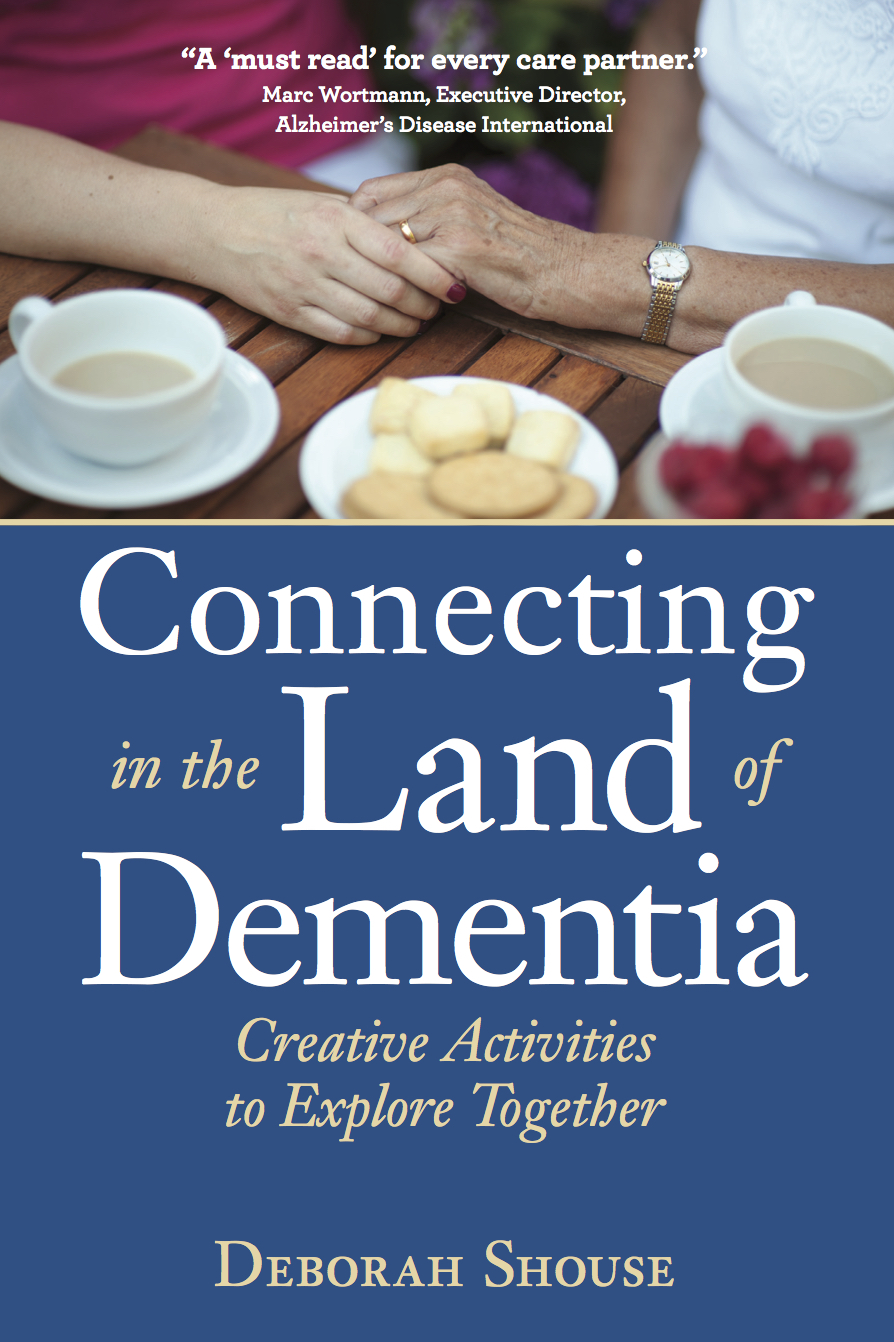
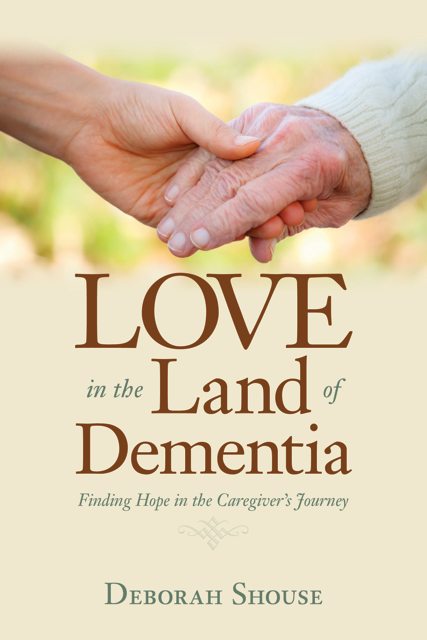
An Inside Look at Creative Aging
We are huddled on the floor, concentrating on our assignment. Each of us has shared an important saying or proverb that impacted our lives and now we are turning those six sayings into a song. We have a daunting five minutes to accomplish this creative task. However, we also have songwriter and musician Vanessa Torres from Lifesongs to guide us. After we've shared our sayings, Vanessa instantly comes up with a theme--These Are Things That I've Learned. Our song centers around that chorus, with each of us weaving in our personal sayings.
In the other three corners of the room, groups are collaborating, turning their sayings into spoken word, dramatic movement, and theatrical improv. Our facilitator, Susan Pearlstein, Founder Emeritus for the National Center for Creative Aging in Washington, DC, and the Founder of Elders Share the Arts in New York City, calls us back to the circle and each group performs their piece. In mere minutes, we have learned something important about each person, we have created an artistic work with people we're just getting to know, and we have appreciated the power of creating something together.
This was an exhilarating beginning to the third annual NCCA conference on creative aging.
These are things I that learned at the conference:
 Every person is inherently creative. Of course, I knew this. But it is so lovely to be reminded in so many ways. It is so lovely to be invited more deeply into your own creativity through song, dance, theater games, art, movement, and brainstorming. It's inspiring to be in a room where so many are expressively at ease with their creative spirits.
Every person is inherently creative. Of course, I knew this. But it is so lovely to be reminded in so many ways. It is so lovely to be invited more deeply into your own creativity through song, dance, theater games, art, movement, and brainstorming. It's inspiring to be in a room where so many are expressively at ease with their creative spirits.
Here are some insights from conference luminaries. Some are not attributed because I was so raptly listening I didn’t write everything down!
“Creativity is a moment when we look at the ordinary, but see the extraordinary.”
“Art is for everyone. It's not a frivolous add-on. It's a vital part of life. Everyone is creative. Dream and dispel the myth that ‘I can't do art.’ Aging has been treated like it’s all gray but it's really expansive colors.” Remarks of Jane Chu, Chairman of the National Endowment for the Arts, Sept 25th, 2016. Click here to enjoy a video of the Chairman
“Feeling useful is a human right.”
“Fifty percent of our elders feel lonely.” Vice Mayor Karsten Klein, The Hague
"By listening closely to one another, we can help illuminate the true character of this nation, reminding us all just how precious each day can be and how great it is to be alive." Dave Isay, founder of StoryCorps, via Eddie Gonzalez
“Bringing what is inside to the outside; it is important to do this as we age.” Mary Luehrsen, National Association of Music Merchants
“Creativity is the connective tissue that we use to build community across diverse differences.” Anne Basting, TimeSlips, ™ Recipient of a 2016 MacArthur Genius Grant
“Instructors need people living with dementia as co-teachers to transform educational goals. “ Dr. Elizabeth Lokon, Opening Minds Through Art
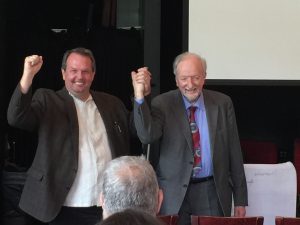
John Killick (right), poet, author and innovator in creativity and dementia, heard this wisdom one day while visiting a memory care community:
“Words of comfort are free, but very necessary.”
“I love it when you hold out your hand and water pours from it.”
“If you don't ask for the moon, you don't even get a piece of cheese.”
“You have to introduce yourself or else it all goes brittle.”
“Life is the slackness, the film and the veil.”
“Every time I look for home, I find you.”
John says, “This tells me that people with dementia are really creative and all we have to do is listen and be enriched.
This is just a soupçon of things that I learned. I wish I could have talked to every person at the conference. I wish I could have listened full on to their stories, to their sayings and proverbs, to the things that they knew and the things they had learned. Which is one reason I hope to return to the conference next year.
Deborah Shouse is the author of Connecting in the Land of Dementia: Creative Activities to Explore Together and Love in the Land of Dementia: Finding Hope in the Caregiver’s Journey.
Therapeutic Puppetry: The Best Rx is Smiles
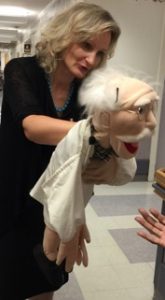 I’ve met a lot of doctors whom I admire, due to their intelligence, listening skills, willingness to collaborate, and their ability to have the occasional hearty laugh. Recently Veronica Kaninska, Certified Therapeutic Recreation Specialist, introduced me to a Doc I instantly fell in love with.
I’ve met a lot of doctors whom I admire, due to their intelligence, listening skills, willingness to collaborate, and their ability to have the occasional hearty laugh. Recently Veronica Kaninska, Certified Therapeutic Recreation Specialist, introduced me to a Doc I instantly fell in love with.
I went on rounds with Veronica and Dr. Moody, who often works with people who are living with dementia. I was so impressed with his knowledge of each individual and the warm way he offered his services. His first patient lit up when he and Veronica strolled toward her.
"How are you today?" he asked in a friendly avuncular voice. "Dr. Moody is here to check your mood. Are you feeling happy?"
"Yes, Dr. Moody, I'm happy now that you're here."
"Let me check your smile."
She smiled broadly and Dr. Moody nodded approvingly.
"Let me see your eyes."
She widened her eyes.
"Good. Your eyes are sparkling. I hope you keep your happy mood all day."
"I will Dr. Moody, I will."
We continued with Dr. Moody checking on some more patients. Each one enjoyed his company and he promised to come again and check on their moods.
After rounds, Veronica slid Dr. Moody off her arm and hung him near another popular puppet, Froggie, who she also uses for therapeutic purposes.
"People who are living with dementia often feel very comfortable communicating with puppets," Veronica says.
I wondered if Dr. Moody was open to new patients and Veronica assured me he was.
Click here to meet the good doctor. 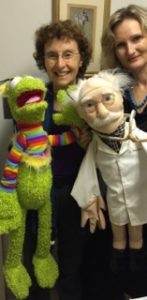
"Puppets break down barriers,” Veronica says. "They have no religion, no gender, and no judgment. People living with dementia often feel comfortable confiding in a puppet."
In a space of three to five minutes, I saw Veronica and Dr. M transform the energy of the people they visited. I asked Veronica to share a few tips for using puppets.
If you'd like to know more about Veronica and her work, read her chapter in Connecting in the Land of Dementia.
Deborah Shouse is the author of Connecting in the Land of Dementia: Creative Activities to Explore Together and Love in the Land of Dementia: Finding Hope in the Caregiver’s Journey.
Shall We Dance?
 Normally, I do not like being the center of attention. But when Sebastian Tomkowski asked me to dance the merengue, I said yes. Actually, my first reply was, "I can't dance." But Sebastian assured me he would guide me, literally, every step of the way.
Normally, I do not like being the center of attention. But when Sebastian Tomkowski asked me to dance the merengue, I said yes. Actually, my first reply was, "I can't dance." But Sebastian assured me he would guide me, literally, every step of the way.
Sebastian is one of the dancers working with Rhythm Breaks Cares (RBC), a non-profit that specializes in bringing the energy and joy of ballroom dance to people who are living with dementia. We were lucky to experience one of RBC's sessions in a New York City care facility.
When everyone was gathered in a circle, Stine Moen, one of RBC's founders, put on some Frank Sinatra tunes. Instantly, one woman danced her way into the room. Her movements were graceful and stylish. When Sebastian invited her to waltz, she readily accepted.
Stine asked a seated women if she'd like to dance. The woman said, "I have this walker and I can't dance with it."
"You can," Stine assured her. "You can use your walker and you and I can dance together."
The woman demurred and sat swaying to the music. But when Stand by Me started playing, she hoisted herself to her feet, grabbed the walker, and began moving rhythmically around the room.
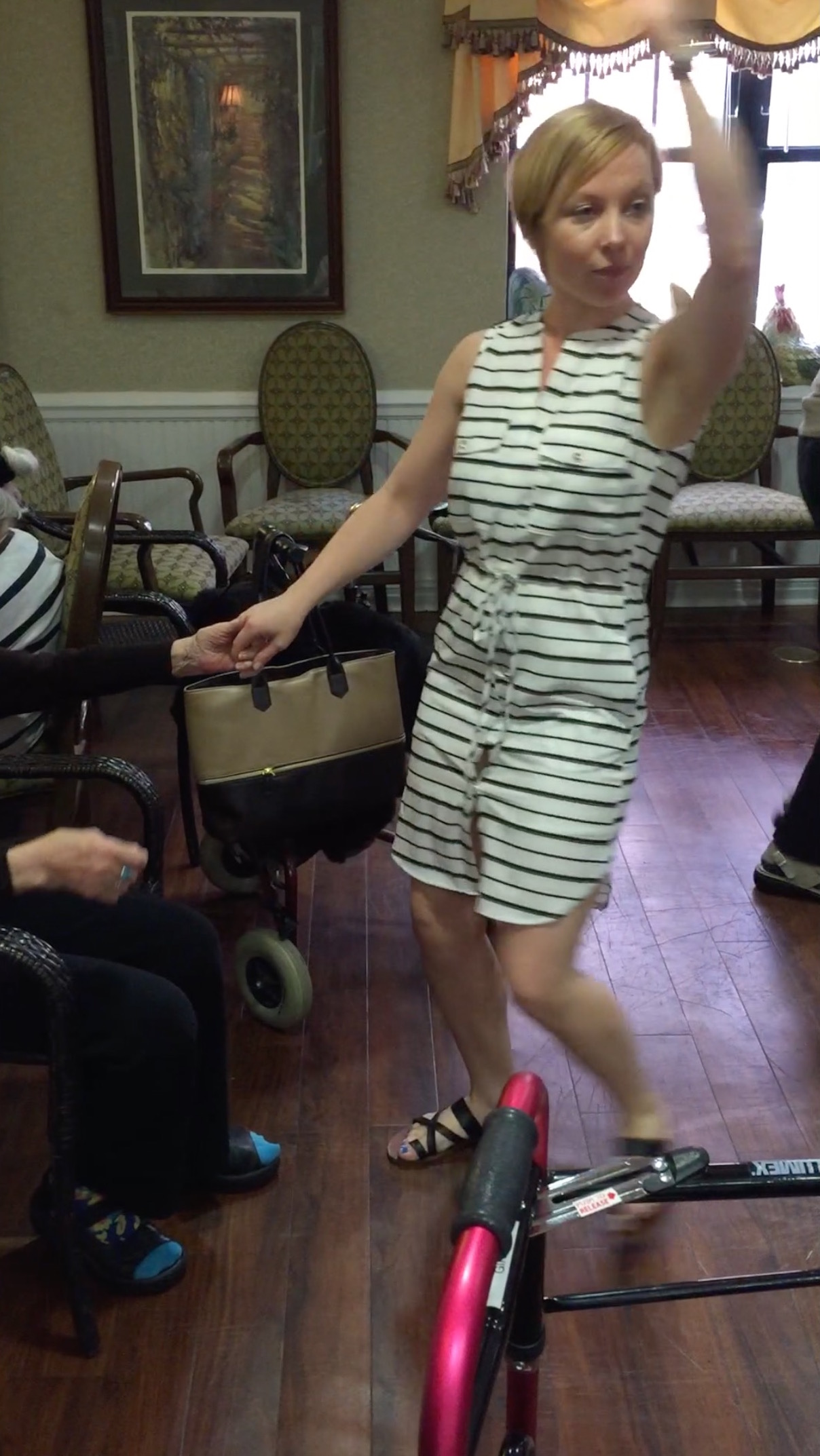 Two men sat in the circle, seemingly not registering the music. When Stine asked if they'd like to dance, one man held out his hand. Stine took his hand and let him guide the movements, while she made fancy arm gestures that looked as though they were waltzing in an elegant ballroom.Click here for dancing ideas.
Two men sat in the circle, seemingly not registering the music. When Stine asked if they'd like to dance, one man held out his hand. Stine took his hand and let him guide the movements, while she made fancy arm gestures that looked as though they were waltzing in an elegant ballroom.Click here for dancing ideas.
One woman sat stock still, but sang along when the song "Fever" played.
"I used to be a singer and my husband played the piano," she told me, when I sat beside her. "But I don't remember the words." She then proceeded to croon along with "I've Got You Under My Skin."
The energy from the music and movement seemed to engage everyone. Even a man who seemed immobile, his mouth tight, his hands clenched up near his face, gradually softened his expression and lowered his hands to his lap.As for me, I reveled in the experience, dancing with the residents or smiling and moving our hands in time to the music. And of course, I loved my once-in-a-lifetime merengue experience.
I asked Stine to offer a few tips for care partners who wanted more movement in their lives.
Here are her suggestions.
"We always start with the music." says Stine. "That sets the tone."
Once the music is playing, if possible, make eye contact. Then smile and hold out a hand. Move in ways appropriate to your partner’s abilities.
Celebrate every movement. Even swaying your arms together to the music is a form of dance.
“It's not about getting the steps right,” Stine says. “It's about connecting through music and movement.”
Want to learn more about the power of dance? Visit the RBC website. Good news—RBC offers training for qualified dancers, so they can bring this exciting program to their own communities.
Click here for additional tips from Stine.
Click here for tips from Sebastian.
Read more about creative programs in Connecting in the Land of Dementia: Creative Activities to Explore Together. Order your copy from your favorite independent or online bookstore.
Deborah Shouse is the author of Connecting in the Land of Dementia: Creative Activities to Explore Together and Love in the Land of Dementia: Finding Hope in the Caregiver’s Journey.

The Power of the Playlist
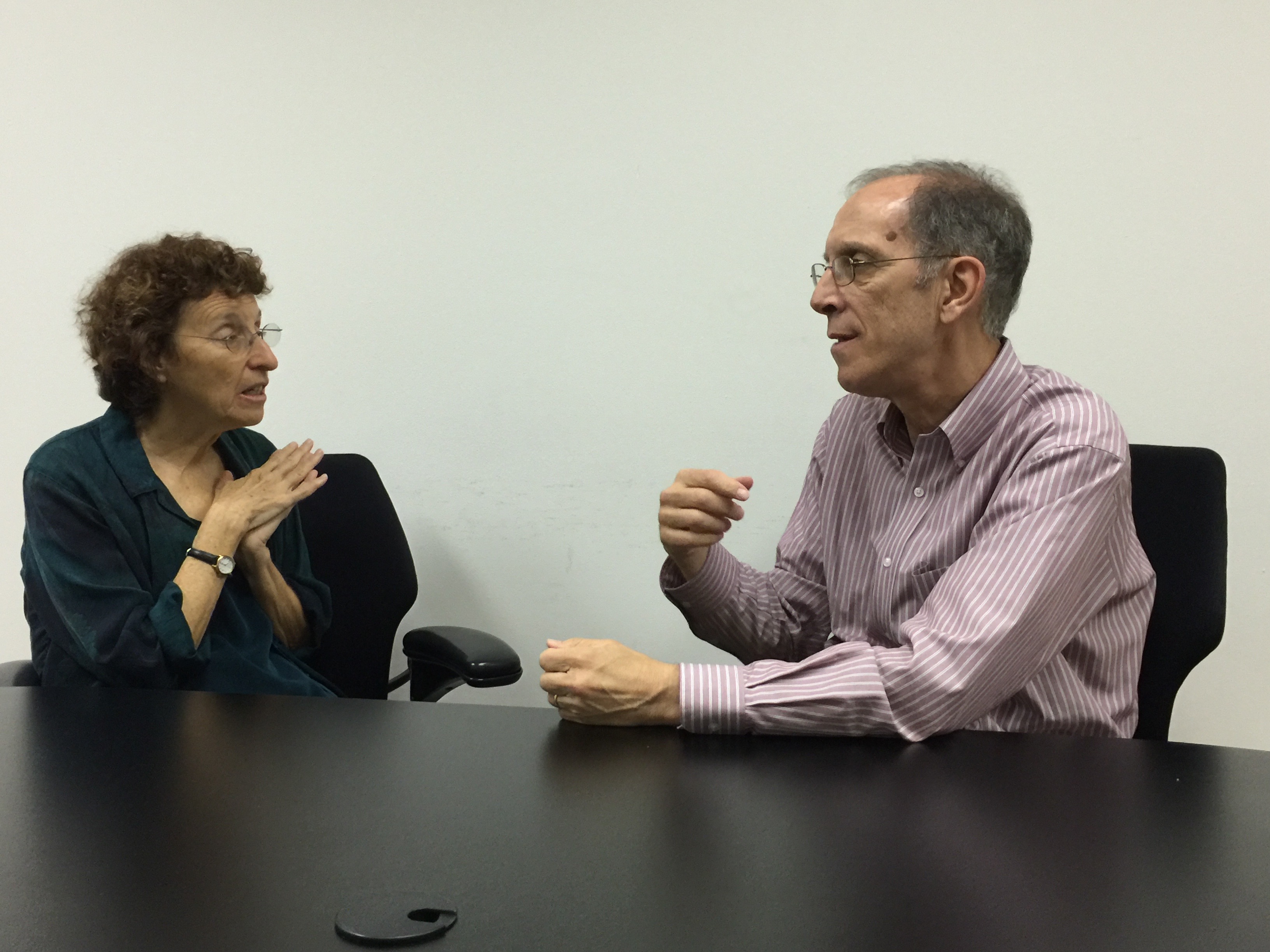 Ron and I were already champions of Dan Cohen’s world-changing Music & Memory program, which is featured in Connecting in the Land of Dementia, but we had never met Dan in person. The moment we learned we were going to New York City, we reached out to Dan and he agreed to meet with us.
Ron and I were already champions of Dan Cohen’s world-changing Music & Memory program, which is featured in Connecting in the Land of Dementia, but we had never met Dan in person. The moment we learned we were going to New York City, we reached out to Dan and he agreed to meet with us.
Dan is a prime example of one collaborative person making a difference for thousands. Eighteen states have already funded Music & Memory rollouts as a best practice approach for care facilities to improve quality of life for persons with dementia. In Toronto, everyone who is diagnosed with dementia receives a free iPod so they can enjoy personalized music. Dan and his team have trained 5000 dementia care managers, who understand how effective this program is. He is currently collaborating with hospitals, hospice, and prisons, as well as long term care communities.
Here is some of the wisdom he shared with us.
“We all need to create our personal play lists now,” Dan says. “Music makes any healthcare encounter better. Whether you’re waiting in the doctor’s office, going into the hospital, attending rehab, or moving into a care community, you’ll have a more comfortable experience when you are able to listen to favorite songs.”
Click here to listen to Dan Cohen.
Click here to learn more about the Music and Memory program.
Read more about Dan’s programs in Connecting in the Land of Dementia: Creative Activities to Explore Together. Order your copy from your favorite independent or online bookstore.
At Long Last: A Page-Turning Love Story
My hands trembled as I reached out my arms. For three long years I’d been working toward this meeting and yearning for this moment. Now, it was finally here. She was more beautiful than I had imagined, with a pleasing weight, just right for holding, just right for spending long hours with. From a glance, her personality seemed strong and purposeful and yet her warm, colorful exterior told me she would be easy to read. As she gradually opened up to me, I felt her power, her accessibility, her willingness to share ideas and wisdom. She felt great; she looked great; and she was brimming with exciting new ideas. Three long years and finally, she was in my arms. I hugged her tightly. At last I was holding my new book, Connecting in the Land of Dementia: Creative Activities to Explore Together
What makes this book unique? It’s the amazing people who contributed to it. During the writing process, I interviewed dozens of innovators across the globe, gathering ideas that engage the creative spirit so you can continue to experience meaningful moments throughout the dementia journey. These luminaries inspired me every step of the way and I am eager to share their ideas with you.
This book is brimming with easy projects using music, art, movies, cooking, gardening, and more. Here are some of the benefits you can look forward to when you do these activities together: Increased energy and socialization, an improved sense of purpose, reduced anxiety, and chances to express yourselves in new and meaningful ways.
Here’s even more good news about the ideas in this book. They’re adaptable for all ages and abilities, and you don’t need to have any special talents. Simply incorporate them into your daily routine and you’ll enrich your time together.
Marc Wortmann, Executive Director, Alzheimer’s Disease International, called the book “A ‘must read’ for every care partner because it really helps you to look at things differently!”
If you’re in the Kansas City area, please join us for the book launch on Sunday afternoon, October 9th, at 1:30 for a reception in the Truman Forum at the Plaza Library. The free presentation will begin at 2:00 This lively program, filled with ideas, stories, and songs, features myself and my partner Ron Zoglin, musical luminaries Rod Fleeman and Cynthia Schroer, and guest speaker Michelle Niedens from the Heart of America Chapter, Alzheimer’s Association.
RSVP 816-701-3407
For those of you in the Washington DC area, please join us at the free Alzheimer’s Foundation of America Caregiver’s Conference on Thursday September 29. We’ll be presenting there, along with other experts in the field. Click here to register.
We recently heard from several readers, saying, “This book is going to help so many people. I’m recommending it to my friends and colleagues.”
That’s what this is all about: enriching people’s lives through meaningful engagement.
It’s a challenge, bringing a new book into the world and we welcome your ideas and help in spreading the word about the book and the event.
You can order a copy now from Rainy Day Books, our book-seller for the event, or online.
Here is some advanced praise:
“A thoughtful and positive guide to the very thing I find myself constantly advocating to doctors, caregivers, and family members—social stimulation and creative arts will limit the need for psychiatric medication and improve the quality of life for those with dementia more than anything else.” Doug Wornell, MD, Life Solutions Group for Geriatric and Neurological Psychiatry
“Buy this book, read it, highlight what inspires you. As you make notes and bend pages to personalize this guide, you are creating a family treasure.” Carol Bradley Burdock, Founder of Minding Our Elders
“Deborah Shouse provides a great public service by shining light on the numerous creative activities that can meaningfully engage the minds and spirits of persons living with dementia. From personalized music to storytelling, Shouse makes it easy for caregivers to understand the various options they have to help their loved ones navigate through their everyday lives.” Dan Cohen, MSW Founding Executive Director, MUSIC & MEMORYsm
An Insider’s Look at Connecting with Music
 Encountering fascinating people is always a highlight of our travels. Our recent trip to New York City was dedicated to meeting innovative people in the field of creativity and dementia. I’d interviewed many of these experts for Connecting in the Land of Dementia via telephone or Skype and I was looking forward to learning from them in person. These are the people who are changing the world and who inspire us to go out there and make our part of the world better. In the next months, I’ll be sharing some of their wisdom with you.
Encountering fascinating people is always a highlight of our travels. Our recent trip to New York City was dedicated to meeting innovative people in the field of creativity and dementia. I’d interviewed many of these experts for Connecting in the Land of Dementia via telephone or Skype and I was looking forward to learning from them in person. These are the people who are changing the world and who inspire us to go out there and make our part of the world better. In the next months, I’ll be sharing some of their wisdom with you.
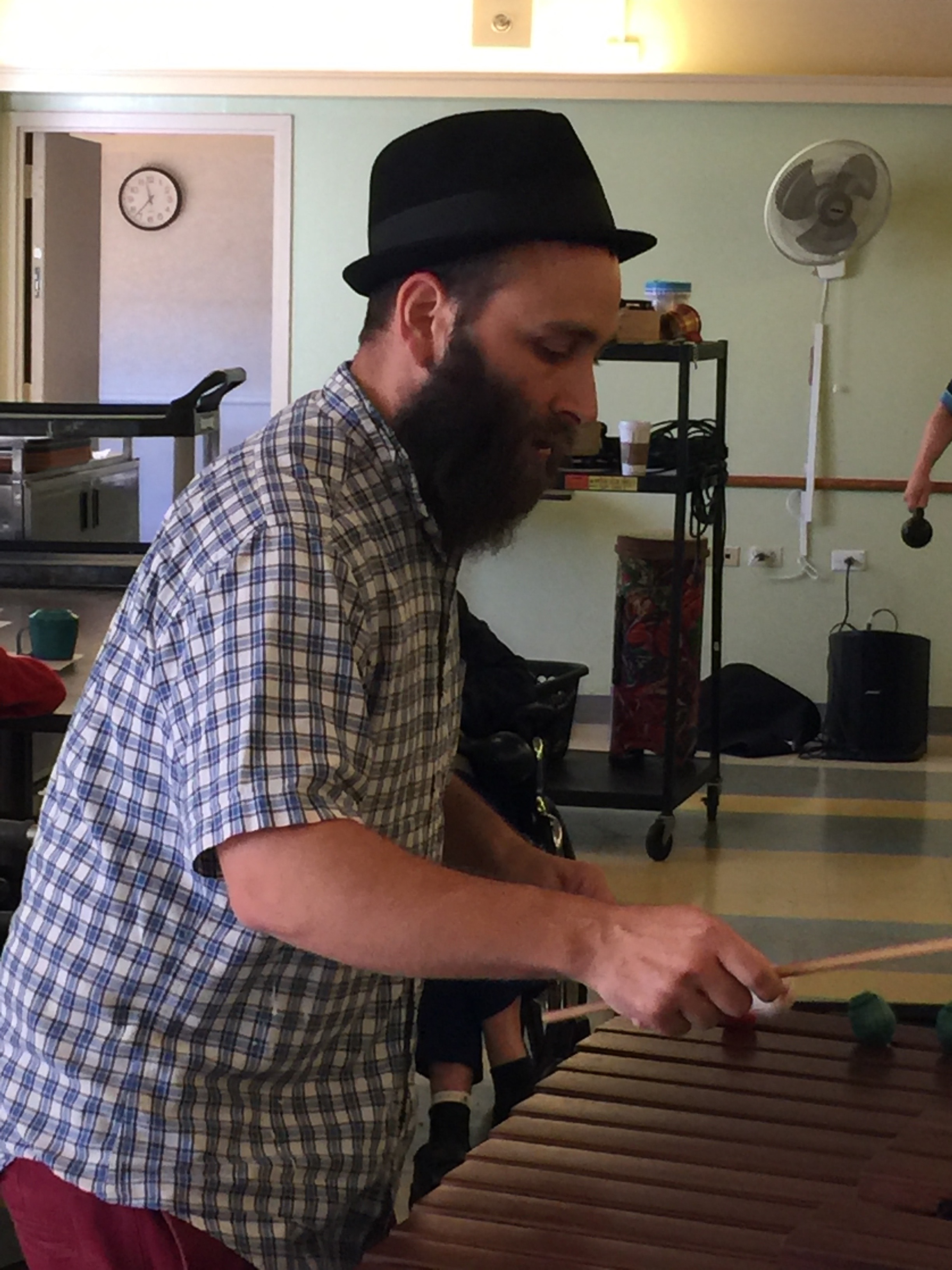 Marlon Sobol grew up with music and understands its universal healing powers. We visited him at a care community in White Plains, NY, where he works as a full-time music therapist. We watched in awe as Marlon worked his carefully orchestrated magic. He started with soothing tones from the marimba, moving into singing everyone’s name as a way of connecting with them. Then he played familiar songs to invite singing along. Finally, he added soundtracks of West African and Caribbean music, which inspired the staff and some of the residents to burst into dancing. In honor of our visit, Marlon played and sang, “Going to Kansas City,” which made us leap out of our chairs, sing along and dance.
Marlon Sobol grew up with music and understands its universal healing powers. We visited him at a care community in White Plains, NY, where he works as a full-time music therapist. We watched in awe as Marlon worked his carefully orchestrated magic. He started with soothing tones from the marimba, moving into singing everyone’s name as a way of connecting with them. Then he played familiar songs to invite singing along. Finally, he added soundtracks of West African and Caribbean music, which inspired the staff and some of the residents to burst into dancing. In honor of our visit, Marlon played and sang, “Going to Kansas City,” which made us leap out of our chairs, sing along and dance.
Here is a tip from Marlon:
“Our names are so important. Music is a way to help people stay connected with their names. I often sing a name as a way of engaging. You can add a name to any simple tune and invite people living with dementia to sing along.”
Click on these shorts videos for other ways to incorporate music and movement into your everyday life.
The power of music and movement
Read more about Marlon’s programs in Connecting in the Land of Dementia: Creative Activities to Explore Together. Order your copy from your favorite independent or online bookstore.

